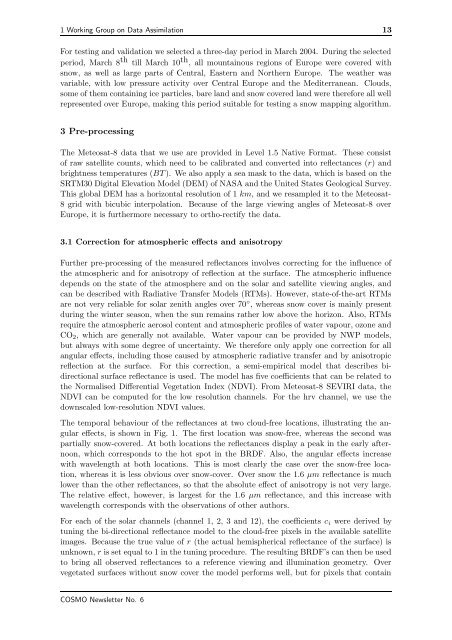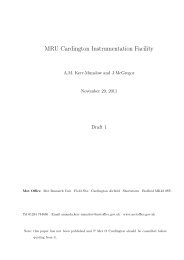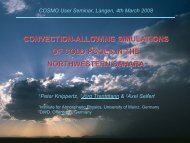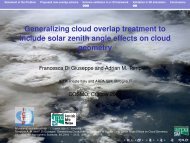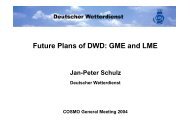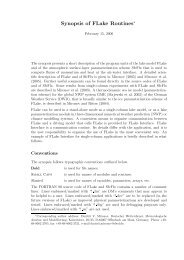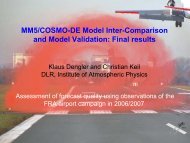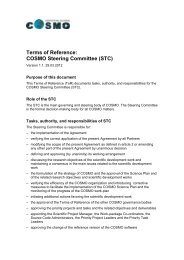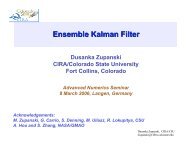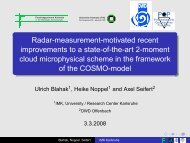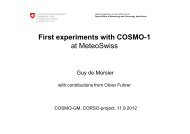document - Cosmo
document - Cosmo
document - Cosmo
Create successful ePaper yourself
Turn your PDF publications into a flip-book with our unique Google optimized e-Paper software.
1 Working Group on Data Assimilation 13<br />
For testing and validation we selected a three-day period in March 2004. During the selected<br />
period, March 8 th till March 10 th , all mountainous regions of Europe were covered with<br />
snow, as well as large parts of Central, Eastern and Northern Europe. The weather was<br />
variable, with low pressure activity over Central Europe and the Mediterranean. Clouds,<br />
some of them containing ice particles, bare land and snow covered land were therefore all well<br />
represented over Europe, making this period suitable for testing a snow mapping algorithm.<br />
3 Pre-processing<br />
The Meteosat-8 data that we use are provided in Level 1.5 Native Format. These consist<br />
of raw satellite counts, which need to be calibrated and converted into reflectances (r) and<br />
brightness temperatures (BT ). We also apply a sea mask to the data, which is based on the<br />
SRTM30 Digital Elevation Model (DEM) of NASA and the United States Geological Survey.<br />
This global DEM has a horizontal resolution of 1 km, and we resampled it to the Meteosat-<br />
8 grid with bicubic interpolation. Because of the large viewing angles of Meteosat-8 over<br />
Europe, it is furthermore necessary to ortho-rectify the data.<br />
3.1 Correction for atmospheric effects and anisotropy<br />
Further pre-processing of the measured reflectances involves correcting for the influence of<br />
the atmospheric and for anisotropy of reflection at the surface. The atmospheric influence<br />
depends on the state of the atmosphere and on the solar and satellite viewing angles, and<br />
can be described with Radiative Transfer Models (RTMs). However, state-of-the-art RTMs<br />
are not very reliable for solar zenith angles over 70 ◦ , whereas snow cover is mainly present<br />
during the winter season, when the sun remains rather low above the horizon. Also, RTMs<br />
require the atmospheric aerosol content and atmospheric profiles of water vapour, ozone and<br />
CO2, which are generally not available. Water vapour can be provided by NWP models,<br />
but always with some degree of uncertainty. We therefore only apply one correction for all<br />
angular effects, including those caused by atmospheric radiative transfer and by anisotropic<br />
reflection at the surface. For this correction, a semi-empirical model that describes bidirectional<br />
surface reflectance is used. The model has five coefficients that can be related to<br />
the Normalised Differential Vegetation Index (NDVI). From Meteosat-8 SEVIRI data, the<br />
NDVI can be computed for the low resolution channels. For the hrv channel, we use the<br />
downscaled low-resolution NDVI values.<br />
The temporal behaviour of the reflectances at two cloud-free locations, illustrating the angular<br />
effects, is shown in Fig. 1. The first location was snow-free, whereas the second was<br />
partially snow-covered. At both locations the reflectances display a peak in the early afternoon,<br />
which corresponds to the hot spot in the BRDF. Also, the angular effects increase<br />
with wavelength at both locations. This is most clearly the case over the snow-free location,<br />
whereas it is less obvious over snow-cover. Over snow the 1.6 µm reflectance is much<br />
lower than the other reflectances, so that the absolute effect of anisotropy is not very large.<br />
The relative effect, however, is largest for the 1.6 µm reflectance, and this increase with<br />
wavelength corresponds with the observations of other authors.<br />
For each of the solar channels (channel 1, 2, 3 and 12), the coefficients ci were derived by<br />
tuning the bi-directional reflectance model to the cloud-free pixels in the available satellite<br />
images. Because the true value of r (the actual hemispherical reflectance of the surface) is<br />
unknown, r is set equal to 1 in the tuning procedure. The resulting BRDF’s can then be used<br />
to bring all observed reflectances to a reference viewing and illumination geometry. Over<br />
vegetated surfaces without snow cover the model performs well, but for pixels that contain<br />
COSMO Newsletter No. 6


